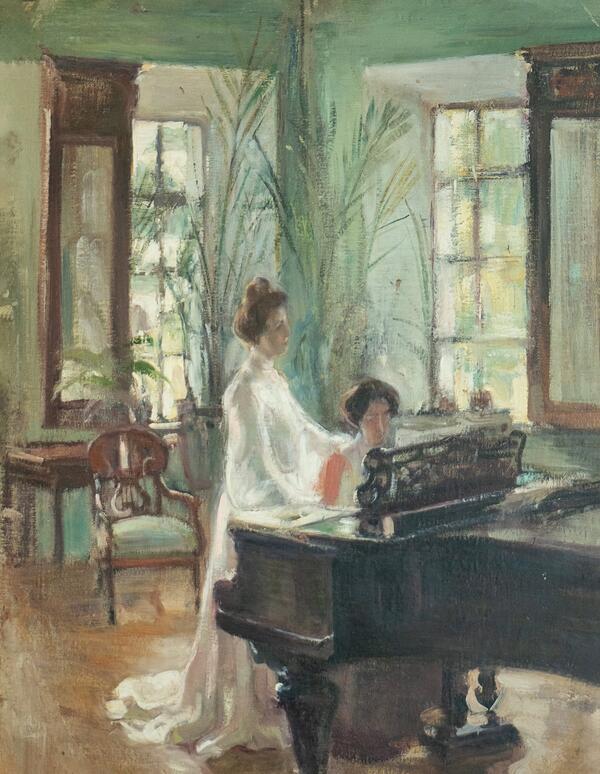The painting “In the Hall” was created by the artist Alexander Sredin. He was born in Moscow to a family of a customs officer in 1872. Sredin received his elementary art education in the early 1880s. Then he took private lessons from the painter Alexander Kiselyov. In 1889, the young man entered the Stroganov School of Art and Industry. During his studies, he attended the classes of Viktor Shtemberg and worked with the graphic artist Sergey Glagol.
In the early 1890s, Alexander Sredin entered the Faculty of Natural Sciences of Moscow University, and after graduating, as the best student, he was left as assistant professor of the Department of Geology. In those years, a private lecturer was called a freelance teacher, equal in rank to an associate professor. However, Sredin became interested in painting and left science. After university, the artist worked in the private workshop of Konstantin Korovin, where he met many patrons of the arts, including Savva Mamontov. Sredin showed his first works at exhibitions of the Moscow Society of Art Lovers.
In 1897, Sredin visited Austria, Italy, Switzerland, and France. He lived in Paris and studied at the academies of famous French painters in those years. In 1902, the artist returned to Moscow, where he participated in exhibitions of the Moscow Association of Artists, published his graphic works and articles in the magazines “Zolotoye Runo”, “Vesy”, “Apollon”.
In Moscow, Sredin painted landscapes and portraits to order. He worked in the techniques of watercolor, oil painting, gouache, pastel.
The main theme of his paintings is the interiors of famous estates and palaces. They are painted in a delicate color scheme. Sredin depicted Empire-style rooms with glittering marble columns, glossy parquet floors, and stylish mahogany furniture. With soft strokes, the artist painted the dull reflections of bronze candlesticks with quivering candle lights, the muted shine of silver family dishes. In their refined color scheme, these interiors are close to Western European painting.
Sredin’s picturesque canvases, as a rule, were chamber and small in size. The historian of Russian culture Dmitry Severyukhin described the painter’s work as follows,
In the early 1890s, Alexander Sredin entered the Faculty of Natural Sciences of Moscow University, and after graduating, as the best student, he was left as assistant professor of the Department of Geology. In those years, a private lecturer was called a freelance teacher, equal in rank to an associate professor. However, Sredin became interested in painting and left science. After university, the artist worked in the private workshop of Konstantin Korovin, where he met many patrons of the arts, including Savva Mamontov. Sredin showed his first works at exhibitions of the Moscow Society of Art Lovers.
In 1897, Sredin visited Austria, Italy, Switzerland, and France. He lived in Paris and studied at the academies of famous French painters in those years. In 1902, the artist returned to Moscow, where he participated in exhibitions of the Moscow Association of Artists, published his graphic works and articles in the magazines “Zolotoye Runo”, “Vesy”, “Apollon”.
In Moscow, Sredin painted landscapes and portraits to order. He worked in the techniques of watercolor, oil painting, gouache, pastel.
The main theme of his paintings is the interiors of famous estates and palaces. They are painted in a delicate color scheme. Sredin depicted Empire-style rooms with glittering marble columns, glossy parquet floors, and stylish mahogany furniture. With soft strokes, the artist painted the dull reflections of bronze candlesticks with quivering candle lights, the muted shine of silver family dishes. In their refined color scheme, these interiors are close to Western European painting.
Sredin’s picturesque canvases, as a rule, were chamber and small in size. The historian of Russian culture Dmitry Severyukhin described the painter’s work as follows,



